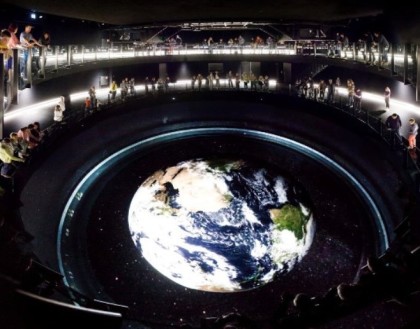Best wishes for 2018
December 21, 2017, 1:15 pm
Filed under:
Directions for Sustainable Innovation,
Laws and Public Interventions,
Sustainability News | Tags:
earth,
Entrepreneurship,
Environmental Impact,
Innovation,
Science,
Space,
SystemsThis summer I visited with my daughters the movie ‘Earth- Our Planet, Our Home’ in the Colombus Earth Center in Kerkrade (The Netherlands). The movie offers a spectacular insight in the life of astronauts:
How are astronauts preparing for their time in space? How do they experience to live in space and view the Earth from above? And what are their reflections once returned at Earth?

Dutch astronaut André Kuipers shared his epiphany moment when he looked down at Earth from space. ‘You realise it is just one Earth that is suitable for us as human beings. Forget about Mars or the Moon: This is the only possible habitat in the whole universe. He continues “We have to rethink energy consumption, food production and cities to allow for 10 billion to live in dignity on this planet’.
To me it is clear: To redesign our energy and food systems, the built environment and more, we will need ‘all hands on deck’. All ‘métiers‘ are needed to make the new systems sustainable, socially just ánd desirable. It is up to all of us, as designers, urban planners, sociologists, economists, data-experts, marketeers, scientists, film makers, architects, accountants, politicians, biochemists, social workers and artists to co-create this new world we would love to live in. (-60% of the cities by 2030 are still to be build yet so we better design them prepared for the future).
Where to start? First: Become a very good designer, urban planner, sociologist, economist, or any other profession. But then: Question your current frameworks and theories: Are they suitable for future proof systems? If not: Find out who is already starting in your domain to (re)design frames, learn more, question and join forces.
A number of new initiatives have emerged in recent years that give some directions. Think about the United Nations Sustainable Development Goals. A call for action to improve the lives of many by 2030 in 17 goals. Another source of inspiration is Kate Raworths’ thinking on the ‘Doughnut Economy’. Raworth rewrites the rules of economy: Our current focus on GDP should be replaced by a focus on the global economy operating in the safe and just space in which everyone enjoys basic social standards and we stay within planetary boundaries. And don’t forget Sir Ellen McArthur who explains to everyone who wants all about the circular economy, as well as Delft University Associate Professor Conny Bakker who developed with her colleagues very le concrete guidelines for circular product design: ‘Products that last’ . Take also the Milano Mayor, Giuseppi Sala for example, who puts into practices that ‘cities can be the trigger for food system change, reduce emission, ensure social inclusion and consumer behaviour change’. Also to be followed is the ‘Food Reform for Sustainable and Health ‘FReSH’ coalition : 37+ businesses and scientists who are determined to identify necessary dietary switches for people and planet and come up with business solutions that suit future proof food systems. Many more examples are out there, just learn, experiment and share what works!
My daughters have not decided yet if they want to be an astronaut or architect (I would be very happy with all choices) but I hope they will continue to be curious and see opportunities to make a better world for all – building on the new insights of many.
Have a happy and relaxed Christmas time with your family and friends – and a great new year. Be curious, be bold, be brave!

Beyond CSR reporting : How to measure the social and environmental impact of CSR strategies ?
September 14, 2010, 2:38 pm
Filed under:
Best Practices in The Netherlands | Tags:
CSR Strategies,
DSM,
Environmental Impact,
Erasmus University,
Measuring Impact,
Rabobank,
Social Impact,
The Netherlands,
TNTNo less than 950 representatives from Dutch industry, NGOs and the scientific world were gathered early September 2010 in Rotterdam, at the conference ‘Corporate Social Responsibility : from Ambition to Impact’ at the Erasmus University. Best CSR Practices of Dutch Sustainability leaders TNT, DSM and Rabobank were presented, as well as key findings of Karen Maas PHD ‘Measuring corporate social performance’ (1)

‘From Ambition to Impact, Corporate Social Responsibility, Conference at the Erasmus School of Accounting and Assurance, 03/09/2010, Rotterdam, The Netherlands
From Ambition to Impact : How to measure ?
‘How to create CSR strategies that create good and measurable results ? was the central theme of the conference, chaired by Marleen Janssen Groesbeek, policy maker, former journalist and author of articles and books on CSR, among them ‘Maatschappelijk Ondernemen’ and ‘Duurzamer Ondernemen’.

Marleen Janssen Groesbeek, policy maker at Eumedion.
As a seasoned sustainability consultant, Karen Maas PHD has observed a wide gap between highly ambitious CSR mission statements and factual CSR reporting. Mission statements often show major ambitions (‘fight climate change’, ‘reduce poverty’ and ‘support biodiversity’), where as annual reports often just list, in some cases, the output, the factual CSR activities – without linking back to societal impact.
An example of this mismatch is a new ‘sustainable building’ in The Netherlands built next to the highway without any public transport access. According to Karen Maas the building is an example of a misfit between an environmental mission and real impact. Despite the better energy performance of the new building, the environmental impact won’t go down substantially as employees need to use their (lease) car to go to the office. Another example is the building of a new school in an African country, without supervision on salary payments in the country. Net result : an abandoned school without any teacher nor children.
Sometimes business people just do not know where to find the right tools or methods to measure social impact of their CSR actions. On the basis of her research, Maas wants to guide people to make right choice of instruments to do measure social impact (people, planet ánd profit) and improve the effectiveness of CSR strategies.
Karen Maas studied the existing 250 (!) methods. She found that methods often just focus on a certain level (enterprise or society), one aspect of the ‘Triple Bottom Line’ (people, planet, profit), and often lack to tell the users ‘how to measure’.
From the 30 methods that measure impact on People, Planet, Profit, only 8 methods really the triple bottom line impact on a society level, or, so to speak, measure social and environmental impact, or, according to Karen Maas ‘measure social impact’ (2, 3). These methods are :
- BoP Impact Assessment Framework (Ted London, 2007)
- Measuring impact Framework (MIF, World Business Council for Sustainable Development, 2009)
- Ongoing Assessment of Social Impacts (OASIS, The Robert Entreprise Development Fund 1999)
- Participatory Impact Assessment (PIA, Feinstein International Center)
- Poverty Social Impact Assessment (PSI, Worldbank, 2000)
- Robin Hood Foundation Benefit-cost ration (Robin Hood Foundation, 2004)
- Social Return on Investment (SRI, Pacific Community Ventures, 2000)
In her PHD report, Karen Maas comes up with detailed recommendations and guidelines. As of 2010 Karen Maas is Scientific Director of CSR education and assistant Professor at Erasmus Centrefor Strategic Philantrophie (www.ecsp.nl). In this role she will continue her research in this area, sharing experiences with students and enterprises.

Karen Maas PHD, Scientific Director of CSR Education at Erasmus University Rotterdam.
Dutch Industry Experiences
Representatives of Sustainability Industry Leaders joined Karen Maas and shared their experiences on ‘how to create good and effective CSR strategies’. Speakers were : TNT (Peter Bakker), DSM (Ben van Dijk) and Rabobank (Bouwe Taverne) and Ernst & Young (Dick van de Waard).
‘Moving the world’, TNTs voluntary emergency logistics activity, is widely known. TNT employees (167k worldwide) are extremely proud of it, tells CEO Peter Bakker. The voluntary activities however are only valid if all other core business activities are aligned with the CSR goals. And should be adapted according to the changing environments of the company. For instance, by opening new operational centers in India, TNT has been faced to more mortal traffic employee incidents. To protect TNT employees in India and to improve the general safety on Indian roads, TNT has become member of the association that promotes traffic safety. An ambitious objective is to decrease CO2 emissions by 45% in 2020 (compared to 1995). TNT is organising worldwide driver contests in a friendly contest to encourage energy efficient drivers. Peter Bakker aims for stronger legislation on CSR reporting as ‘everybody is doing something different’. He also emphasises the key role of empowerment of employees. Bakker recently changes his Porsche for a Toyota Prius to set an exmple. However, he adds, CSR is not about hybride cars nor technical solutions : it is all about people and their behaviour.


CEO Peter Bakker of TNT Group
At DSM, the ‘Green Bonus’ helps to push Eco Innovation. The ‘Green Bonus’ for top managers is a promising tool to increase the effectiveness of sustainability goals, explains Director Special Projects Ben van Dijk. 50% of the variable bonus is related to sustainability. Some elements : (1) 70% of the new product launches should be defined as ‘Eco +’ products (2) Energy consumption should be down 2% per year, (3) Employee Engagement should be above a certain level. The debate on Green Bonus with shareholders and Advisory Board has been extensive but constructive. Eventually all agreed with the new remuneration guidelines, as the new rule would be for the benefit of DSM and society. To read more about Sustainable Innovation Best Practices, click here.


Ben van Dijk, Director Special Projets at DSM.
Bouwe Taverne of the Dutch Rabobank, explains how the Rabobank supports both incremental sustainable innovation (changing the course of the huge ship) as well as supporting outside start-ups (Green Tech Fund). An example of the first category of embedding sustainability principles in the banking sector is the lobby of the Rabobank to create a quality label applicable to all investments with an option to ‘opt-out’. Instead of ‘Sociallly Responsible Investments’ all investments to be sustainable (with an opt-out). An example of the second category is the newly created ‘Green Tech Fund’. Read more about Rabobanks Best Practices here.


Bouwe Taverne, Manager Sustainable Development at Rabobank
Dick de Waard, Partner at Ernst & Young and Professor at the Groningen University on Register Accountancy is responsible for auditing annual reports. He urges for introducing ‘CSR or employee satisfaction bonus’ in all companies to counterweight the current financial focus of the top management of many companies.

Dick de Waard, Partner at Ernst & Young
Conclusion
Companies can measure social impact – and should, states Karen Maas. Measuring social impact contributes to the creation of effective and realistic CSR goals. By coming up with advice on the right type of measurement methods she is ‘spot on’ – as many Sustainability Directors have difficulties to pick the right one methodology.
CSR missions are now embedded in core business, show representatives of Dutch industry. Promising practices are eco-innovation initiative es at DSM (similar to the criteria set by Philips for its respective industries), a financial stimulus for top managers when achieved sustainability goals like at DSM (see also my earlier article on AkzoNobel) and eco-efficiency driving courses for employees, such as practices by the TNT Group.
If you want to read more about Best Practices in The Netherlands of Sustainable Innovation, I recommend you to read my articles on telecom operator KPN, energy provider Eneco, and local community of The Hague.
Sources: 1. Presentations at the conference ‘Corporate Social Responsibility : from Ambition to Impact’(Symposium ‘Maatschappelijk Verantwoord Ondernemen : van ambitie naar impact’, Erasmus University, Rotterdam, The Netherlands http://symposium.esaa.nl ; 2. PHD report ‘Corporate Social Performance’, from output management to impact measurement’, Karen Elisabeth Huguette Maas, 2 december 2009, Erasmus Universiteit Rotterdam. http://www.hartstichting.nl/9800/13333/13371/proefschrift_karen_maas ; 3. ‘Maatschappelijke Impact, dilemma metingen MVO acviteiten’, bu Astrid van Unen, in : P-plus, april 2010,











